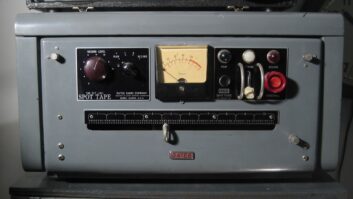Here is a sampling from the Radio World reader mailbag.
Is Anyone There?
Ken Deutsch wondered “Why Is Radio So Hard to Listen To?”
He asked, “Is there no one in the building actually listening to the station?” That answer would be no.
Not long ago I went back to help a cluster in Louisville that was missing its chief engineer. It was my first visit in more than 20 years.
When I’d been there last, more than 100 folks worked at six stations in the building. On my return, there were approximately five full-time — the general manager, the operations manager, three sales people.
There were no program directors. No music directors. No traffic people. Those functions had been outsourced to people in other markets. Accounts payable clerk? She was in Wichita. Only one station had a live morning show. Everyone else was syndicated. Only two of them did live afternoon drive.
And as far as commercial breaks? Three six-minute breaks an hour; and in those breaks, there might have been one or two local spots; everything else was national sales.
— Scott Cason
Never Been Worse
I agree with Ken’s comments about trying to enjoy radio listening.
When I was designing audio processing equipment, I remember being asked by PDs to make their FM signals “as loud as possible, but still ‘legal’ to the FCC.”
Once during an NAB booth demo, a chief engineer noticed the total modulation meter on my Belar FM monitor displaying the result of my processing. He said the reading “looked like DC” — there was almost no variation in level. I explained that I was only doing what my customers wanted, but looking back, I feel I should apologize.
I recall a conversation with my friend Matt Connor, a chief at various FM stations that used my processors. We wondered what would happen if we reached out to PDs in each market and suggested that each station reduce their peak audio levels by the same amount; there would be parity and no reason for an ongoing “loudness war.”
I’m sorry we never actually tried it. The listeners would have been the better for it. Could you trust a group of competing PDs to keep such an agreement? I don’t know.
But even with today’s digital high-quality audio delivery and equipment, on-air-quality has never been worse. It’s hard to listen to, and I wish that I had a better answer.
— Steve Hemphill, Owner, Solid Electronics Labs, WA2XMN, Alpine, N.J.
Reason to Listen
I was at a popular station when an edict came down that we were to reduce commercial stops to two per hour. Whatever was scheduled, there it was — it could be three, four, five, even 10 units. I was shocked, but in the PPM world it seems to work (sort of, if not for the advertisers or listeners).
Before they slimmed down AM receiver bandwidth, AM-only radios sounded great. When I was in Detroit, CKLW on a Chrysler AM radio sounded as good as FM.
AM stereo radios had a circuit that expanded bandwidth in the presence of stereo. My father-in-law’s Oldsmobile displayed the beauty of 1000-watt WCOL’s stereo while driving through Columbus in 1987.
I worked with a great broadcaster in Nashville in the 1980s. He noted that our station’s cume was massive while the TSL was struggling. He’d say, “People WANT to listen to our station!”
Technical issues, content, inferior receivers … don’t stop there. Ken, you’re not alone in your concern. Those of us who still listen daily want AM/FM to succeed.
Statistics show that the general audience is still tuning in yet stations continue to do things that drive them away. If streaming ever becomes as simple to activate as AM/FM, the lights will go out on traditional radio as we know it. That hasn’t happened yet, but we can’t assume radio will always be in the mix unless we give the audience a reason to keep it there.
— Dave Mason, On-Air Host
Amateurs Need ITU Help
Paul McLane’s Q&A with Rebecca Hanson, director general of the North American Broadcasters Association, was very informative.
As radio amateurs, we are also indebted to the frequency allocations laid out by the International Telecommunications Union and the support we get from ITU’s cousin, the International Amateur Radio Union.
The spectrum layout clearly states that 80 meters (3.5 to 4.0) and 40 meters (7.0 to 7.2) are exclusively for amateur use, yet these two bands are constantly being “invaded” by Russian military use including beacons on ~7.039 MHz and CW military traffic when Chinese and Russian military conduct training exercises on ~3.885 MHz.
On 40 meters, use of voice transmissions on frequencies below 7.050 is against regulations, yet every morning that part of the spectrum is littered with Indonesian voice stations (allegedly on fishing trawlers), sounding like a 40-meter version on the 11-meter wasteland.
Another recent disaster was the invasion of OTH radar centered exactly on 7.033 MHz, making legitimate communications with Asia impossible. Signal headings pointed to eastern Russia as the source of the radar.

When is the ITU going to enforce the use of amateur bands for amateur traffic only? It was bad enough back in the day that we had to put up with the original woodpecker, parked on 13.980 MHz, just below 20 meters.
Having this kind of activity smack in the middle of a daily-used radio spectrum is clearly unacceptable, yet we amateurs have no lobby that will do something about it.
If the buck doesn’t stop at the ITU, then where does it stop?
— Ron Fitch, WQ6X, President, Amateur Radio Club of Alameda, Alameda, Calif.
More on SDR Receivers
Regarding the article “SDR: The Next Level of Shortwave Listening” by James Careless:
No doubt these receivers are a whole giant leap forward. I started my long path to radio 60 years ago when my father got back the Hallicrafters SX-42 receiver he’d loaned to a friend. Together we rebuilt it — mostly replacing capacitors — and I was hooked listening to shortwave broadcasts all night. And I still have that receiver.
But SDRs also work for remote receiving over the internet.
The Maritime Radio Historical Society (MRHS) has SDRs available at its Point Reyes receiving site. The location was chosen by Dr. Harold Beverage for RCA’s Pacific receiving station. It is a magnificent HF receiving site because it is on a peninsula with the ocean on three sides. The only harmful emissions are from cattle, and those are not in the RF domain.
Our HF receiving antenna is a TCI 530 omnidirectional 3–30 MHz antenna.
The RCA-era “Marconi T” MF antenna is down as I write, but we finally got funding from the National Park Service to restore the poles and guys and will soon get that antenna back in service.
You can access the receivers through our website.
— Bill Ruck, Maintenance, Maritime Radio Historical Society, Inverness, Calif.
[Check Out More Letters at Radio World’s Reader’s Forum Section]







